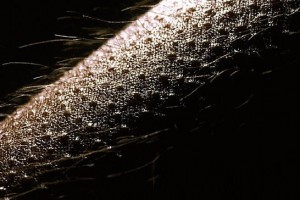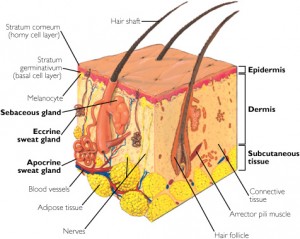Why People Get Goose Bumps
 Today I found out why you get goose bumps when it’s cold or as result of a strong emotion.
Today I found out why you get goose bumps when it’s cold or as result of a strong emotion.
It turns out, goose bumps are an involuntary reflex of mammals called piloerection, usually triggered by a hormone released on certain situations that causes their body hair to stand. With time, humans have evolved to have less body hair, so what we see during certain situations such as a temperature drop or strong emotions are goose bumps on the skin rather than standing hair.
So how are goose bumps formed? The reflex brought on by stimulus such as cold, fright or strong emotions – fear, admiration, sexual arousal, awe, etc. causes an involuntary discharge from the sympathetic nervous system which responds to stimulus we may not be consciously aware of, and in turn triggers contraction of the little arrectores pilorum muscles (the arrector pili are extremely small muscle fibers that are attached to each hair follicle on your body).
 This discharge causes contraction of the hair erector muscles (arrector pili). Each contracting muscle creates a shallow depression on the skin surface so the surrounding area protrudes. That is why the hair follicles elevate above the rest of the skin and goose bumps appear.
This discharge causes contraction of the hair erector muscles (arrector pili). Each contracting muscle creates a shallow depression on the skin surface so the surrounding area protrudes. That is why the hair follicles elevate above the rest of the skin and goose bumps appear.
The reflex of goose bumps is known as the piloerection or horripilation and occurs in many other mammals. The main reason though for goose bumps is the subconscious release of a stress hormone adrenaline. While in animals , this hormone is released as a fight-or-flight reaction to cold or stressful situation, in humans adrenaline may be also be released during strong emotional reactions such as excitement.
Bonus Facts:
- The goose bumps effect gets its name from geese. Goose feathers grow from stores in the epidermis which are similar to human follicles. When feathers are plucked, a goose’s skin gets protrusions. These bumps resemble the human phenomenon.
- Goose bumps are also called goose flesh, chill bumps, chicken skin, funky spots, etc. The medical term for goose bumps is “cutis anserina”, “cutis” meaning “skin” and “anser” meaning “goose”.
- Bristling, a phenomenon in fur-covered animals similar to goose bumps, also keeps them warmer by increasing the amount of air between hairs which traps body heat.
- In humans, goose bumps are the strongest on the forearms, but also occur on the legs, neck, and other areas of the skin that have hair. Goose bumps are very rare on the face.
| Share the Knowledge! |
|





I would guess its a similar reaction to what many animals have such as cats when they are frightened or stressed, it is supposed to make you look larger and harder to defeat.
You are right. Goose bumps are are involuntary reflex of your body to certain situations, but it is also voluntary, like me, I can control my goose bumps. Starting from my nape all the way down to my calves.